Promotes interdisciplinary research on biodiversity, structure and functioning of marine ecosystems.
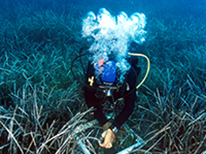 The mission of the Integrative Marine Ecology Department (IME Department) is to conduct and to promote multi-faceted, scientific research focusing on the functioning of pelagic and benthic systems at the organism, community and ecosystem levels.
The mission of the Integrative Marine Ecology Department (IME Department) is to conduct and to promote multi-faceted, scientific research focusing on the functioning of pelagic and benthic systems at the organism, community and ecosystem levels.
We focus on biological, physiological and evolutionary processes shaping organism-organism and organism-environmental interactions, and their implications for the preservation of biodiversity and environmental sustainability. Our research also explores the use of marine biodiversity for biotechnological applications in the food and health sectors.
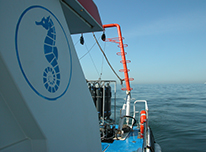 Our shared expertise covers such fields as ecology, behaviour, taxonomy, phylogeny, population genetics, physiology, ecotoxicology, genomics and transcriptomics, chemistry, oceanography and mathematical modelling and includes a range of observational and experimental approaches both in the field as well as under controlled laboratory conditions.
Our shared expertise covers such fields as ecology, behaviour, taxonomy, phylogeny, population genetics, physiology, ecotoxicology, genomics and transcriptomics, chemistry, oceanography and mathematical modelling and includes a range of observational and experimental approaches both in the field as well as under controlled laboratory conditions.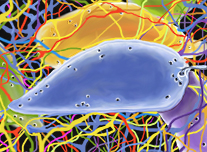 Sampling of pelagic and ecosystems includes the use of oceanographic vessels, small boats, and SCUBA diving; the department also has logistic and instrument facilities that include a collection of marine microalgae, climate-controlled rooms for experimental work on marine organisms, fermenters and photobioreactors for the mass cultivation of microalgae, indoor and outdoor mesocosms for manipulative experiments in situ.
Sampling of pelagic and ecosystems includes the use of oceanographic vessels, small boats, and SCUBA diving; the department also has logistic and instrument facilities that include a collection of marine microalgae, climate-controlled rooms for experimental work on marine organisms, fermenters and photobioreactors for the mass cultivation of microalgae, indoor and outdoor mesocosms for manipulative experiments in situ.
Other available platforms include light, confocal, SEM and TEM microscopy, molecular biology techniques, biological assays, flow cytometry, image analysis, HPLC, spectrophotometry and spectrofluorimetry.
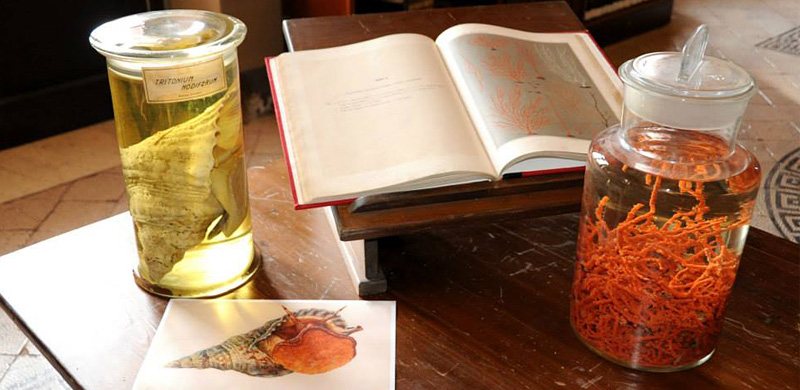
The collections of the Zoological Station were created to research on marine species in the Gulf of Naples. Thanks to the inventiveness and skill of preparator Salvatore Lobianco, who began working at SZN at the age of 14 years at the Zoological Station, the collection soon became known for the beauty and perfection of its preserved marine animals.
These were sold to museums, institutes, and individuals all over the world, and many samples are still on display in the major natural history museums in, for instance, Naples, Florence and Berlin.
Projects
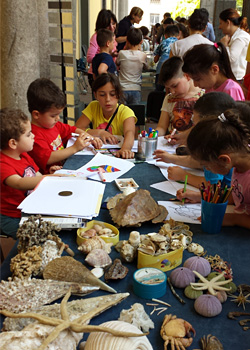 The Museum, as part of MAB, participates in educational projects organized by the unit: during the years 2014-2015 and as part of activities for schools, a classroom was set up specially equipped to view microscopic marine organisms. This tool allows showing sea life and microorganism al diversity. In external activities ("Collecting Nature") we introduce children to scientific drawing, by means of observation of live shells and marine animals, and showing them the designs kept in our Historical Archive, made by two professional artists: Comingio Merculiano and Vincenzo Serino.
The Museum, as part of MAB, participates in educational projects organized by the unit: during the years 2014-2015 and as part of activities for schools, a classroom was set up specially equipped to view microscopic marine organisms. This tool allows showing sea life and microorganism al diversity. In external activities ("Collecting Nature") we introduce children to scientific drawing, by means of observation of live shells and marine animals, and showing them the designs kept in our Historical Archive, made by two professional artists: Comingio Merculiano and Vincenzo Serino.
For 2015 we do not foresee specific types of activity because the collections are temporarily stored, but following the move of the museum to the Casina del Boschetto, located in Villa Comunale, we will greatly expand our portfolio of training, animated visits, workshops and meetings aimed to teachers, school children and the public at large.
The mission of the new SZN Museum is to introduce various audiences to the rich historical, cultural, scientific and technological patrimony of the SZN. The collection will include marine animals, antique research instruments, precious books and historical documents (photographs, letters, drawings etc.).
Contacts
Claudia di Somma
Tel. +39 081 5833291
e-mail: claudia.disomma(at)szn.it
2018
Foo S.A., Byrne M, Gambi M.C. (2018) Residing at low pH matters, resilience of the egg jelly coat of sea urchins living at a CO2 vent site. Marine Biology, 165:97 https://doi.org/10.1007/s00227-018-3359-2
Kumar A., AbdElgawad H., Castellano I., Selim S., Beemster G.T.S., Asard H., Buia M.C., Palumbo A. (2018). Effects of ocean acidification on the levels of primary and secondary metabolites in the brown macroalga Sargassum vulgare at different time scales. Science of the Total Environment, https://doi.org/10.1016/j.scitotenv.2018.06.176.
Lucey NM, Lombardi C, Florio M, Rundle SD, Calosi P, Gambi MC (2018) A comparison of life-history traits in calcifying Spirorbinae polychaetes living along natural pH gradients. Marine Ecology Progress Series 589: 141-152.
Mutalipassi M, Di Natale M, Mazzella V, Zupo V (2018) Automated culture of aquatic model organisms: shrimp larvae husbandry for the needs of research and aquaculture. Animal 12: 155-163.
Porzio L, Buia MC, Ferretti V, Lorenti M, Rossi M, Trifuoggi M, Vergara A, Arena C (2018). Photosynthesis and mineralogy of Jania rubens at low/high pCO2: a future perspective. Science of total Environment, 628-629: 375-383. doi: 10.1016/j.scitotenv.2018.02.065.
2017
Ambroso, S., Salazar, J., Zapata-Guardiola, R., Federwisch, L., Richter, C., Gili, J.M. & Teixidó, N. (2017). Pristine populations of habitat-forming gorgonian species on the Antarctic continental shelf. Scientific Reports, 7(1), 12251.
Crisci, C., Ledoux, J.B., Mokhtar-Jamaï, K., Bally, M., Bensoussan, N., Aurelle, D., Cebrian, E., Coma, R., Féral, J.P., Rivière, M., Linares, C., López-Sendino, P., Marschal, C., Ribes, M., Teixidó, N., Zuberer, F., & Garrabou, J. (2017). Regional and local environmental conditions do not shape the response to warming of a marine habitat-forming species. Scientific Reports, 7(1), 5069.
Gambi, M.C., Carugati, F., Crocetta, F., Gianguzza, P. (2017). Aplisie in …piscina! Una popolazione di Aplysia dactylomela (Heterobranchia, Aplysiidae) nell’isola di Ustica. Notiziario S.I.B.M. 72, 99-102
Gara, A. B., Kolsi, R. B. A., Chaaben, R., Hammami, N., Kammoun, M., Patti, F. P., El Feki, A., Fki, L., Belghith, H. and Belghith, K. (2017). Inhibition of key digestive enzymes related to hyperlipidemia and protection of liver-kidney functions by Cystoseira crinita sulphated polysaccharide in high-fat diet-fed rats. Biomedicine & Pharmacotherapy 85, 517-526.
Garrabou, J., Sala, E., Linares, C., Ledoux, J.B., Montero-Serra, I., Dominici, J.M., Kipson, S., Teixidó, N., Cebrian, E., Kersting, D.K. & Harmelin, J.G. (2017). Re-shifting the ecological baseline for the overexploited Mediterranean red coral. Scientific Reports, 7, p.42404.
Giangrande A., Gambi M.C., Gravina M.F. (2017). Paradigm shifts in community ecology: open vs closed units, challenges and limits of connectivity studies. Marine Ecology, 38(6): DOI.org/10.1111/maec.12480.
Hardege J.D., Rotchell J.M., Gambi M.C., Waege J. (2017). Target gene expression studies on Platynereis dumerilii and Platynereis cfr massiliensis at the shallow CO2 vents off Ischia, Italy. Estuarine Coastal and Shelf Science. DOI.org/10.1016/j.ecss.2017.11.012.
Kolsi, R. B. A., Frikha, D., Salah, H. B., Jribi, I., Patti, F. P., Allouche, N., Belghith, K. (2017). Phenolic composition and biological activities of brown alga Dictyopteris polypodioides. Journal of Pharmacognosy and Phytochemistry, 6(2), 109-113.
Kumar A., Abdelgawad H., Castellano I., Lorenti M., Delledonne M., Beemster G.T.S., Asard H., Buia M.C., Palumbo A. (2017). Physiological and biochemical analysis shed light into the response of Sargassum vulgare to ocean acidification at different time scales. Frontiers in Plant Science, 8:570. doi: 10.3389/fpls.2017.00570
Kumar A, Castellano I, Patti FP, Delledonne M, Abdelgawad H, Beemster Gts, Asard H, Palumbo A, Buia MC (2017) Molecular response of Sargassum vulgare to acidification at volcanic CO2 vents - insights from de novo transcriptomic analysis. Molecular Ecology, DOI: 10.1111/mec.14034
Meccariello, A., Monti, S. M., Romanelli, A., Colonna, R., Primo, P., Inghilterra, M. G., Del Corsano, G., Ramaglia, A., Iazzetti, G., Chiarore, A., Patti, F. P., Heinze, S.D., Salvemini, M., Lindsay, H., Chiavacci, E., Burger, A., Robinson, M.D., Mosimann, C., Bopp, D., Saccone, G. (2017). Highly efficient DNA-free gene disruption in the agricultural pest Ceratitis capitata by CRISPR-Cas9 ribonucleoprotein complexes. Scientific Reports, 7(1), 10061.
Nogueira, P., Gambi, M. C., Vizzini, S., Califano, G., Tavares, A. M., Santos, R., & Martínez-Crego, B. (2017). Altered epiphyte community and sea urchin diet in Posidonia oceanica meadows in the vicinity of volcanic CO2 vents. Marine Environmental Research, 127, 102-111.
Porzio L., Buia M.C., Lorenti M., De Maio A., Arena C. (2017). Physiological responses of a population of Sargassum vulgare (Phaeophyceae) to high pCO2/low pH: implications for its long-term distribution. Science of The Total Environment, 576: 917-925. doi: 10.1016/j.scitotenv.2016.10.096
Ravaglioli C., Lauritano C., Buia M.C., Balestri E., Capocchi A., Fontanini D., Pardi G., Tamburello L., Procaccini G., Bulleri F. (2017). Nutrients loading modulates seagrass response to ocean acidification. Scientific Reports, 7: 13732, DOI:10.1038/s41598-017-14075-8
Scartazza A., Moscatello S., Gavrichkova O., Buia M.C., Lauteri M., Battistelli A., Lorenti M., Calfapietra C., Brugnoli E. (2017). Carbon and nitrogen allocation strategy in Posidonia oceanica is altered by seawater acidification. Science of The Total Environment, 607-608:954-964. doi:10.1016/j.scitotenv.2017.06.084.
Santin A., Moschin E, Lorenti M, Moro I, Buia MC (2017). Caulerpa cylindracea and ocean acidification. In: E. Ozhan (Ed), Coastal and Marine Sciences, Engineering, Management and Conservation:505-514. ISBN: 978-605-85652-6-5.
Scipione, M.B., Kroeker, K.J., Ricevuto, E., Gambi, M.C. (2017). Amphipod assemblages along shallow water natural pH gradients: data from artificial substrata (Island of Ischia, Italy). Biodiversity Journal 8 (2), 469-470.
Scipione M.B., Lo Brutto S., Cirino P., Di Capua I., Guglielmo R., Patti F.P. & Sarno D. (2017). A network of italian amphipodologist in the frame of MOTAX. Biodiversity Journal,8, 661-663.
Vizzini S., Martínez-Crego B., Andolina C., Massa-Gallucci A., Connell S.D., Gambi M.C. (2017). Ocean acidification as a driver of community simplification via the collapse of higher-order and rise of lower-order consumers. Nature Scientific Report 7: 4018. DOI: http://10.0.4.14/s41598-017-03802-w
Wäge, J., Rotchell, J. M., Gambi, M. C., Hardege, J. D. (2017). Target gene expression studies on Platynereis dumerilii and Platynereis cfr massiliensis at the shallow CO2 vents off Ischia, Italy. Estuarine, Coastal and Shelf Science. doi.org/10.1016/j.ecss.2017.11.012
Wäge J., Valvassori G., Hardege J.D., Shulze A., Gambi M.C. (2017). The sibling polychaetes Platynereis dumerilii and Platynereis massiliensis in the Mediterranean Sea: are phylogeographic patterns related to exposure to ocean acidification? Marine Biology, 164: 199. DOI 10.1007/s00227-017-3222-x
Zupo, V., Alexander, T.J. and Edgar, G. J. (2017). Relating trophic resources to community structure: a predictive index of food availability. Royal Society Open Science 4, 160515.
2016
Corriero, G., Pierri, C., Accoroni, S., Alabiso, G., Bavestrello, G., Barbone, E., Bastianini, M., Bazzoni, A. M., Aubry, F. B., Boero, F. Buia, M.C., Cabrini, M., Camatti, E., Cardone, F., Cataletto, B., Cattaneo Vietti, R., Cecere, E., Cibic, T., Colangelo, P., De Olazabal, A., D'Onghia, G., Finotto, S., Fiore, N., Fornasaro, D., Fraschetti, S., Gambi, M.C., Giangrande, A., Gravili, C., Guglielmo, R., Longo, C., Lorenti, M., Lugliè, A., Maiorano, P., Mazzocchi, M.G., Mercurio, M., Mastrototaro, F., Mistri, M., Monti, M., Munari, C., Musco, L., Nonnis Marzano, C., Padedda, B.C., Patti, F.P., Petrocelli, A., Piraino, S., Portacci, G., Pugnetti, A., Pulina, S., Romagnoli, T., Rosati, I., Sarno, D., Satta, C.T., Sechi, N., Schiaparelli, S., Scipione, B., Sion, L., Terlizzi, A., Tirelli, V., Totti, C., Tursi, A., Ungaro, N., Zingone, A., Zupo, V., Basset, A. (2016). Ecosystem vulnerability to alien and invasive species: a case study on marine habitats along the Italian coast. Aquatic Conservation-Marine and Freshwater Ecosystems 26, 392-409.
Gambi MC, Patti FP (2016). Ritrovamento di “perle” in un esemplare del mollusco bivalve Crassostrea gigas (Thurnberg) (Ostreidae, Bivalvia) a Salerno. Notiziario S.I.B.M. 69: 44-48.
Gambi MC, Lorenti M, Patti FP, Zupo V (2016). An annotated list of alien marine species of the Ischia Island (Gulf of Naples). Notiziario S.I.B.M. 70: 64-68.
Gambi MC, Musco L, Giangrande A, Badalamenti F, Micheli F, Kroeker KJ. (2016). Distribution and functional traits of polychaetes in a CO2 vent system: winners and losers among closely related species. Marine Ecology Progress Series, 550:121-13.
Gara, A.B., R.B.A. Kolsi, R. Chaaben, N. Hammami, M. Kammoun, F.P. Patti, A. El Feki, L. Fki, H. Belghith and K. Belghith (2016). Inhibition of key digestive enzymes related to hyperlipidemia and protection of liver-kidney functions by Cystoseira crinita sulphated polysaccharide in high-fat diet-fed rats. Biomedicine & Pharmacotherapy 85: 517-526. DOI: 10.1016/j.biopha.2016.11.059.
Kamenos N., Perna G., Gambi, M.C., Micheli F., Kroeker K. (2016) Coralline algae in a naturally acidified ecosystem persist by maintaining control of skeletal mineralogy and size. Proceedings Royal Society B (Biological Sciences), 283: 20161159. dx.doi.org/10.1098/rspb.2016.1159.
Kolsi R.B.A., Fakhfakh J., Krichen F., Jribi I., Chiarore A., Patti F.P., Blecker C., Allouche N., Belghith H. and Belghith K. (2016). Structural characterization and functional properties of antihypertensive Cymodocea nodosa sulfated polysaccharide. Carbohydrate Polymers.
Lucey, N. M., Lombardi, C., Florio, M., DeMarchi, L., Nannini, M., Rundle, S., Gambi, M. C. and Calosi, P. (2016). An in situ assessment of local adaptation in a calcifying polychaete from a shallow CO2 vent system. Evolutionary Applications.
Porzio L, Buia MC, Lorenti M, De Maio A, Arena C (2016) Physiological responses of a population of Sargassum vulgare (Phaeophyceae) to high pCO2/low pH: implications for its long-term distribution. Science of The Total Environment, http://dx.doi.org/10.1016/j.scitotenv.2016.10.096
Ricevuto, E., Lanzoni, I., Fattorini, D., Regoli, F. and Gambi, M. C. (2016). Arsenic speciation and susceptibility to oxidative stress in the fanworm Sabella spallanzanii (Gmelin) (Annelida, Sabellidae) under naturally acidified conditions: An in situ transplant experiment in a Mediterranean CO2 vent system. Science of the Total Environment 544, 765-773.
Rihab Ben Abdallah Kolsi, Jawhar Fakhfakh, Fatma Krichen, Imed Jribi, Antonia Chiarore, Francesco Paolo Patti, Christophe Blecker, Noureddine Allouche, Hafedh Belghith, Karima Belghith (2016). Structural characterization and functional properties of antihypertensive Cymodocea nodosa sulfated polysaccharide. Carbohydrate Polymers 05/2016; DOI:10.1016/j.carbpol.2016.05.098.
Tarallo A, Gambi M.C., D’Onofrio G. (2016) Lifestyle and DNA base composition in polychaetes. Physiological Genomics 48: 883-888. DOI: 10.1152/physiolgenomics.00018.2016.
Turner L.M., Ricevuto E., Massa-Gallucci A., Lorenti M., Gambi M.C., Calosi P. (2016) Metabolic responses to high pCO₂ conditions at a CO₂ vent site in the juveniles of a marine isopod assemblage. Marine Biology, 163: 211. DOI 10.1007/s00227-016-2984-x.
2015
BASSO L., HENDRIKS I., RODRIGUEZ-NAVARRO A., GAMBI M.C., DUARTE C.M. 2015. High pCO2 conditions affect growth, survival and metabolism of juvenile pen shells (Pinna nobilis) at a natural CO2 vent system (Italy). Estuaries and Coasts. DOI 10.1007/s12237-014-9936-9
CORRIERO G., PIERRI C., SACCORONI S., ALABISO G., BAVESTRELLO G., BARBONE E., et al. 2015. Ecosystem vulnerability to alien and invasive species: a case study on marine habitats along the Italian coast. Aquatic Conservation: Marine Freshwater Ecosystems. DOI: 10.1002/aqc.2550
CRISE A., KABERI H., RUIZ J., ZATSEPIN A., ARASHKEVICH E., GIANI M., KARAGEORGIS A.P., et al. 2015. A MSFD complementary approach for the assessment of pressures, knowledge and data gaps in Southern European Seas: The PERSEUS experience. Marine Pollution Bulletin, 95: 28–39.
GIAKOUMI S., POSSINGHAM H.P., GOBERT S., BOUDOURESQUE C.-F., GAMBI M.-C., KATSANEVAKIS S., et al. 2015. Towards a framework for assessment of cumulative human impacts on food webs. Conservation Biology, 29(4): 1228-1234. DOI: 10.1111/cobi.12468.
KUMAR A., CASTELLANO I., PATTI F.P., PALUMBO A., BUIA M.C. 2015. Nitric oxide in marine photosynthetic organisms. Nitrix Oxide, 47: 34-39.
LAURITANO C., RUOCCO M., DATTOLO E., BUIA M.C., SILVA J., SANTOS R., OLIVÉ I.,COSTA M.M., PROCACCINI G. 2015. Response of key stress-related genes of the seagrass Posidonia oceanica in the vicinity of submarine volcanic vents. Biogeosciences, 12(6): 4947-4971.
LOMBARDI C., COCITO S., GAMBI M.C., TAYLOR P.D. 2015. Morphological plasticity in a calcifying modular organism to a more acidic ocean: evidence for an in situ transplant at a natural CO2 vent system. Royal Society Open Science, 2: 140413. Dx.doi.org/10.1098/rsos.140413
LORENTI M., KEPPEL E., PETROCELLI A., SIGOVINI M., TAGLIAPIETRA D. 2015. The non-indigenous Paranthura japonica Richardson, 1909 (Isopoda: Anthuroidea: Paranthuridae) from the Mar Piccolo lagoon, Taranto (Italy, Mediterranean Sea). Environmental Science and Pollution Research. DOI 10.1007/s11356-015-4994-5
LUCEY N.M., LOMBARDI C., DE MARCHI L., SCHULZE A., GAMBI M.C., CALOSI P. 2015. To brood or not to brood. Are marine organisms that protect their offspring more resilient to ocean acidification? Scientific Reports, 5:12009. DOI: 10.1038/srep12009
MAIBAM C., FINK P., ROMANO G., BUIA MC, BUTERA E, ZUPO V. 2015. Centropages typicus (Crustacea, Copepoda) reacts to volatile compounds produced by planktonic algae. Marine Ecology, 36(3): 819-834. DOI:10.1111/maec.12254.
MASTROTOTARO F., CHIMIENTI G., MATARRESE A., GAMBI M.C., GIANGRANDE A. 2015. Growth and population dynamics of the non-indigenous species Branchiomma luctuosum (Annelida, Polychaeta, Sabellidae) in the Ionian Sea (Mediterranean Sea). Marine Ecology, 36: 517-529. DOI. 10.1111/maec.12160
RICEVUTO E., BENEDETTI M., REGOLI F., SPICER J.I., GAMBI M.C. 2015. Antioxidant capacity of polychaetes occurring along a natural pCO2 gradient: results of an in situ reciprocal transplant experiment. Marine Environmental Research. DO10.1016/j.marenvres.2015.09.005I
RICEVUTO E., VIZZINI S., GAMBI M.C. 2015. Ocean acidification effects on stable isotope signatures and trophic interactions of polychaete consumers and organic matter sources at a CO2 shallow vent system. Journal Experimental Marine Biology and Ecology, 468: 105-117. Dx.doi.org/10.1016/j.jembe.2015.03.016
TURNER L.M., RICEVUTO E., MASSA GALLUCCI A., GAMBI M.C., CALOSI P. 2015. Energy metabolism and cellular homeostasis trade-offs provide the basis for a new type of sensitivity to ocean acidification in a marine polychaete at a high CO2 vent: adenylate and phosphagen energy pools vs. carbonic anhydrase. The Journal of Experimental Biology, 218: 2148-2151. DOI: 10.1242/j eb.117705.
VASAPOLLO C., VILLANO L., GAMBI M.C. 2015. Spatio-temporal variability of borer polychaete in Posidonia oceanica beds and its relation to meadow structure. Mediterranean Marine Science, 16(1): 136-146. DOI. 10.12681/mms.863
ZUPO V., MAIBAM C., BUIA M.C., GAMBI M.C., PATTI F.P., SCIPIONE M.B., LORENTI M., FINK P. 2015. Chemoreceptor of the seagrass Posidonia oceanica by benthic invertebrates is altered by seawater acidification. Journal of Chemical Ecology. DOI 10.1007/s10886-015-0610-x
ZUPO V., MAIBAM C., FINK P., VON ELERT E. 2015. Effect of storage on the fatty acid content of foods for post-larvae of the crustacean decapod Hippolyte inermis. Invertebrate Reproduction and Development. DOI http://dx.doi.org/10.1080/07924259.2014.1001498
2014
DATTOLO E., RUOCCO M., BRUNET C., LORENTI M., LAURITANO C., D'ESPOSITO D., DE LUCA P., SANGES R., MAZZUCA S., PROCACCINI G. 2014. Response of the seagrass Posidonia oceanica to different light environments: insights from a combined molecular and photo-physiological study. Marine Environmental Research 101: 225-236. http://dx.doi.org/10.1016/j.marenvres.2014.07.010
DONNARUMMA L., LOMBARDI C., COCITO S., GAMBI M.C. 2014. Settlement pattern of Posidonia oceanica epibionts along a gradient of ocean acidification: an approach with mimics. Mediterranean Marine Science, 15(3): 498-509. DOI. 10.12681/mms.677.
HARVEY B.P., AL-JANABI, B. BROSZEIT S., CIOFFI R., KUMAR A., ARANGUREN-GASSIS M., BAILEY A., GREEN L., GSOTTBAUER C.M., HALL E.F., LECHLER M., MANCUSO F.P., PEREIRA C.O., RICEVUTO E., SCHRAM J.B., STAPP L.S., STENBERG S., SANTA ROSA L.T. 2014. Evolution of marine organisms under climate change at different levels of biological organization. Water, 6(11): 3545-3574.
GARRARD S., GAMBI M.C., SCIPIONE M.B., PATTI F.P., LORENTI M., ZUPO V., PATERSON D.M., BUIA M.C. 2014. Indirect effects may buffer negative responses of seagrass invertebrate communities to ocean acidification. Journal of Experimental Marine Biology and Ecology, 461: 31-38. http://dx.doi.org/10.1016/jembe.2014.07.011
GIANGRANDE A., GAMBI M.C., MICHELI F., KROEKER K.J. 2014. Fabriciidae (Annelida, Sabellida) from a naturally acidified coastal system (Italy) with description of two new species. Journal Marine Biological Association U.K., 94(7): 1417-1427.doi.org/10.1017/S0025315414000678
GUGLIELMO R. GAMBI M.C., GRANATA. A., L. GUGLIELMO L., MINUTOLI R. 2014. Composition, abundance and distribution of holoplanktonic polychaetes within the Strait of Magellan (southern America) in austral summer. Polar Biology, 37(7): 999-1015. DOI 10.1007/s00300-014-1496-8
MAIBAM C., ROMANO G., FINK P., BUIA M.C., GAMBI M.C., SCIPIONE M.B., PATTI F.P., LORENTI M., BUTERA E., ZUPO V. 2014. Relevance of wound-activated compounds produced by diatoms as toxins and infochemicals for benthic invertebrates. Marine Biology, 161 (7): 1639-1652. DOI 10.1007/s00227-014-2448-0.
PERGENT G., BAZAIRI H., BIANCHI C.N., BOUDOURESQUE C.N.,BUIA M.C., CALVO S., CLABAUT P., HARMELIN-VIVIEN M.,MATEO M.A., MONTEFALCONE M., MORRI C., ORFANIDIS S., PERGENT-MARTINI C., SEMROUD R., SERRANO O., THIBAUT T., A TOMASELLO A., VERLAQUE M. 2014. Climate change and Mediterranean seagrass meadows: a synopsis for environmental managers. Mediterranean Marine Science. Doi: http://dx.doi.org/10.12681/mms.621
RICEVUTO E., KROEKER K.J., FERRIGNO F., MICHELI F., GAMBI M.C. 2014. Spatio-temporal variability of polychaete colonization at volcanic CO2 vents (Italy) indicates high tolerance to ocean acidification. Marine Biology, 161(12): 2909-2919. DOI 10.1007/s00227-014-2555-y.
ZUPO V., JUTTNER F., MAIBAM C., BUTERA E., BLOM J.F. 2014. Apoptogenic Metabolites in Fractions of the Benthic Diatom Cocconeis scutellum parva. Marine Drugs 2014, 12, 547-567; doi:10.3390/md12010547
2013
ARIAS A., GIANGRANDE A., GAMBI M.C., ANADON N. 2013. Biology and new records of the invasive species Branchiomma bairdi (Annelida: Sabellidae) in the Mediterranean Sea. Mediterranean Marine Science, 14(1): 162-171. http://dx.doi.org/10.12681/mms.363
CALOSI P., RASTRICK S.P.S., LOMBARDI C., DE GUZMAN H.J., DAVIDSON L., JAHNKE M., GIANGRANDE A., HARDEGE J.D., SCHULZE A, SPICER J.I., GAMBI M.C. 2013. Adaptation and acclimatization to ocean acidification in marine ectotherms: an in situ transplant experiment with polychaetes at a shallow CO2 vent system. Philosophical Transactions of the Royal Society B: 368, 20120444. dx.doi.org/10.1098/rstb 2012.0444.
KROEKER K., MICHELI F., GAMBI M.C. 2013. Ocean acidification causes ecosystem shifts via altered competitive interactions. Nature Climate Change, 3: 156-159. DOI: 10.1038/NClimate1680
KROEKER K.J., GAMBI M.C., MICHELI F. 2013. Altered recovery dynamics result in homogenous assemblages in an acidified ocean. Proceedings of the National Academy of Sciences, USA (PNAS). DOI 10.1073/pnas.1216464110
MAJEWSKA R., GAMBI M.C., TOTTI C.M., DE STEFANO M. 2013. Epiphytic diatom communities of Terra Nova Bay (Ross Sea, Antarctica): structural analysis and relations to algal host. Antarctic Science, 25(4): 475-500.DOI:10.1017/S0954102012001101
MAJEWSKA R., GAMBI M.C., TOTTI C.M., PENNESI C., DE STEFANO M. 2013. Growth form analysis of epiphytic diatom communities of Terra Nova Bay (Ross Sea, Antarctica). Polar Biology, 36: 73-86. DOI 10.1007/s00300-012-1
MERON D., BUIA M.C., FINE M., BANIN E. 2013. Changes in microbial communities associated with the sea anemone Anemonia viridis in a natural pH gradient. Microbial Ecology, 65(2): 269-276.
PARAPAR J., MOREIRA J., GAMBI M.C., CARAMELO C. 2013. Morphology and biology of Laetmonice producta producta Grube (Polychaeta, Aphroditidae) in the Bellingshausen Sea and Antarctic Peninsula (Southern Ocean, Antarctica). Italian Journal of Zoology,. DOI. http://dx.doi.org/10.1080/11250003.2012.758783
PORZIO L., GARRARD S., BUIA M.C. 2013. The effect of ocean acidification on early algal colonization stages at natural CO2 vents. Marine Biology, 160 (8), 2247-2259
SCIPIONE M.B. 2013. Do studies of functional groups give more insight to amphipod biodiversity? Crustaceana. 86 (7-8), 955-1006.
SCIPIONE M.B. 2013. On the presence of the Mediterranean endemic Microdeutopus sporadhi Myers, 1969 (Crustacea: Amphipoda: Aoridae) in the Gulf of Naples (Italy) with a review on its distribution and ecology. Mediterranean Marine Science, 14(3): 56-63.
2012
BARNICH R., GAMBI M.C., FIEGE D. 2012. Revision of the genus Polyeunoa McIntosh, 1885 (Polychaeta, Polynoidae). Zootaxa, 3523: 25-38.
COCITO S., LOMBARDI C., CIUFFARDI F., GAMBI M.C. 2012. Colonization of Bryozoa on seagrass Posidonia oceanica 'mimics': biodiversity and recruitment pattern over time. Marine Biodiversity, 42(2): 189-201. DOI 10.1007/s12526-011-0104-1
GARRARD S.L., HUNTER R.C., FROMMEL A.Y., LANE A.C., PHILLIPS J.C., COOPER E., DINESHRAM R., CARDINI U., McCOY S.J., ARNBERG M., RODRIGUES ALVES B.G., ANNANE S., DE ORTE M.R., KUMAR A., AGUIRRE-MARTINEZ G.V., MANEJ R.H., BASALLOTE M.D., APE F., TORSTENSSON A., BJOERK M.M. 2012. Biological impacts of ocean acidification: a postgraduate perspective on research priorities. Marine Biology online first DOI: 10.1007/s00227-2033-3.
NAPPO M., BERKOV.S., MASSUCCO C., DI MARIA V., BASTIDA J., CODINA C., AVILA C., MESSINA P., ZUPO V., ZUPO S. (2012) Apoptotic activity of the marine diatom Cocconeis scutellum and eicosapentaenoic acid in BT20 cells. Pharmaceutical Biology 50(4): 529-535 DOI: 10.3109/13880209.2011.611811
TOVAR-HERNÁNDEZ M.A, YÁÑEZ-RIVERA B., GIANGRANDE A., GAMBI M.C. 2012. Notes on the species of Perkinsiana (Polychaeta: Sabellidae) from Antarctica with the description of P. brigittae sp. nov. Zootaxa, 3485: 56–68.
VASAPOLLO C., GAMBI M.C. 2012. Spatio-temporal variability in Posidonia oceanica seagrass meadows off the Western Mediterranean: Shoot density and plant features. Aquatic Biology, 16: 163-175
ZENETOS A., GOFAS S., MORRI C., ROSSO A., VIOLANTI D., GARCIA-RASO J.E., CINAR M.E., ALMOGI-LABIN A., ATES A.S., AZZURRO E., BALLESTEROS E., BIANCHI C.N., BILECENOGLU M., GAMBI M.C., GIANGRANDE A., GRAVILI C., HYAMS-KAPHZAN O., KARACHLE V., KATSANEVAKIS S., LIPEJ L., MASTROTOTARO F., MINIEUR F., PANCUCCI-PAPADOPOULOU M.A., RAMOS ESPLA A., SALAS C., SAN MARTIN G., SFRISO A., STREFTARIS N., VERLAQUE M. 2012. Alien species in the Mediterranean Sea by 2012. A contribution to the application of European Union’s Marine Strategy Framework Directive (MSFD). Part 2. Patterns in introduction trends and pathways. Mediterranean Marine Science 13/2: 328-352.
Publications presented at Congresses and scientific meetings
2015
DI CIOCCIO D., BUIA MC, ZINGONE A. 2015. Ocean acidification will not deliver us from Ostreopsis. Proceedings ISSHA Conference.
2014
GIANGRANDE A., GAMBI M.C. 2014. Policheti alloctoni in Mediterraneo: stato dell’arte e possibili impatti. Biologia Marina Mediterranea, 21(1): 89-92.
2013
GAMBI M.C., D’AMBRA I., FIORITO G., SAGGIOMO V. 2013. The "Archivio Moncharmont": a pioneering marine biodiversity assessment in the Gulf of Naples (Italy). In: Groeben C. (Ed), Places, People, Tools: Oceanography in the Mediterranean and Beyond. Giannini Editore (Napoli). Pubblicazioni della Stazione Zoologica di Napoli IV: 459-467.
GAMBI M.C., BARBIERI F. 2013. Regression of Halophila stipulacea (Forssk.) Aschers. (Hydrocharitaceae) in the Harbor of Palinuro (Salerno, Italy). Biologia Marina Mediterranea, 20(1): 134-135.
SANDULLI R., BAVESTRELLO G., CHEMELLO R., GAMBI M.C., GIANGRANDE A., RUSSO G.F., TERLIZZI A. 2013. Prospettive e criticità sul ruolo del benthos nella direttiva sulla Marine Strategy. Biologia Marina Mediterranea, 20(1): 88-102.
2012
CHIARORE A, PATTI FP, BUIA MC 2012. Morphological and genetic variability of Sargassum vulgare. Pilot study of a population in the acidified zone of the "Castello Aragonese" (Ischia Island, Gulf of Naples). Biologia Marina Mediterranea, 19(1): 57-58.
GAMBI M.C., RICEVUTO E. 2012. "Messages in the bubbles". Il Geosito marino del Castello Aragonese di Ischia (Napoli): relazioni tra geologia e biologia in rapporto al cambiamento climatico. In: D’Angelo S., Fiorentino A. (a cura di). Atti ISPRA, Roma: 89-96. www.isprambiente.gov.it/it/pubblicazioni/atti
GAMBI M.C., BARBIERI F. 2012. Population structure of the gorgonian Eunicella cavolinii in the "Grotta Azzurra" cave off Palinuro, after the mass mortality event in 2008. Biologia Marina Mediterranea, 19(1) 174-175.
GAMBI M.C., BENEDETTI-CECCHI L. 2012. Approcci di studio ai gradienti di fattori ecologici in ambiente marino e risposte di specie e comunità. Biologia Marina Mediterranea, 19(1): 26-36.
RICEVUTO E., LORENTI M., PATTI F.P., SCIPIONE M.B., GAMBI M.C. 2012. Temporal trends of benthic invertebrate settlement along a gradient of ocean acidification at natural CO2 vents (Tyrrhenian Sea). Biologia Marina Mediterranea,19(1): 49-52
RUOCCO M., BRUNET C., LORENTI M., LAURITANO C., D’ESPOSITO D., RICCIO M., PROCACCINI G. 2012. Posidonia oceanica photoadaptation to the depth gradient. Biologia Marina Mediterranea, 19 (1): 63-64.
ZINGONE A, BUIA MC 2012. Il Golfo di Napoli. In R Bertone (ed) La rete italiana per la ricerca ecologica a lungo termine (LTER Italia). Situazione e prospettive dopo un quinquennio di attività (2006-2011). Aracne Editrice, Roma; 186-192. ISBN 978-88-548-4661-6.
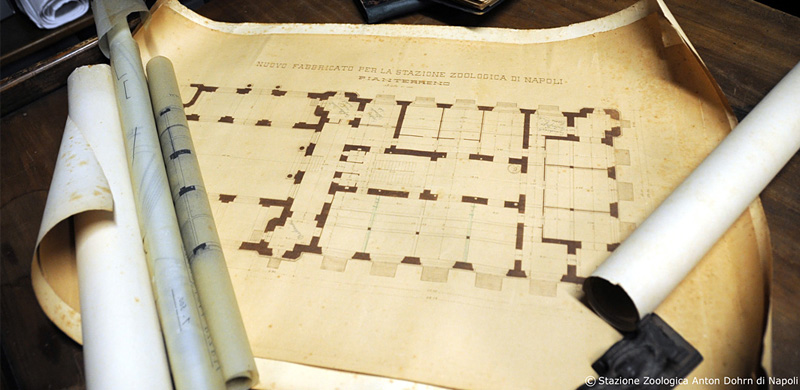
The Historical Archives of the Stazione Zoologica Anton Dohrn of Naples (ASZN) preserve documents related to the activity of the Institution from its foundation (1872) onwards. The archive was set up in 1969. It included institutional documents, private and public correspondence, photographs, scientific drawings, etc., and now holds also numerous historical documents donated to the Institute over the years.
The Historical Archives are subject to the Decreto Legislativo n. 42 - 22 January 2004 (Codice dei Beni Culturali e del paesaggio), and are under the supervision of the Ministry of Cultural Heritage and Activities and Tourism - Soprintendenza Archivistica della Calabria e della Campania.
The mission of the Historical Archives of the Stazione Zoologica Anton Dohrn is the management, protection and enhancement of archival heritage preserved, and its appropriate use for scientific, educational and cultural.
Services *
- Archival research
- Consultation
- Photocopies and Reproductions
- Loan (only for institutions)
- Authorization for Publications
* Access and facilities are open to the public, with some restrictions.
Projects
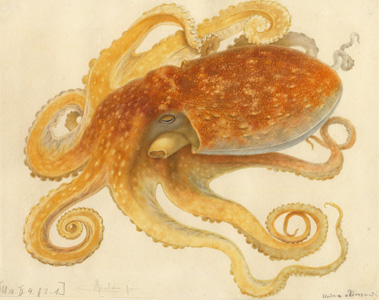 The Archive, as part of MAB, participates in educational projects organized by the unit: during the years 2014-2015 and as part of activities for schools ("Catch a Book", "The School goes on board"). It introduces children to the life sciences through the story of the Institute. Within the frame of the project “La Villa Comunale di Napoli” we show them the evolution of the three buildings of which the SZN is now composed (by September 1873 the first one was ready. A second building, connected with the first by a bridge, was added in 1885-1888, the courtyard and the east wing were built in 1905).
The Archive, as part of MAB, participates in educational projects organized by the unit: during the years 2014-2015 and as part of activities for schools ("Catch a Book", "The School goes on board"). It introduces children to the life sciences through the story of the Institute. Within the frame of the project “La Villa Comunale di Napoli” we show them the evolution of the three buildings of which the SZN is now composed (by September 1873 the first one was ready. A second building, connected with the first by a bridge, was added in 1885-1888, the courtyard and the east wing were built in 1905).
As part of the dissemination activities “Maggio dei Monumenti”, we contextualized the history of the Institute within the history and growth of the Vity of Naples: the City assigned to Anton Dohrn, free of charge, a plot of land right on the water front on which he was allowed to construct and operate the SZN.
In 2015, the "International Year of light and technologies based on light" we analyzed, in collaboration with “ABB Reportages,” the person of Etienne-Jules Marey, doctor, engineer, artist and Neapolitan author of the first film images of the history.
Marey was a close friend of Dohrn, with whom he shared dreams, hopes and ideas that led him to analyze the movement of animals and man, and introduced new insights in the realms of science, art and culture.
Contacts
Claudia di Somma
Tel. +39 081 5833291
e-mail: claudia.disomma(at)szn.it










